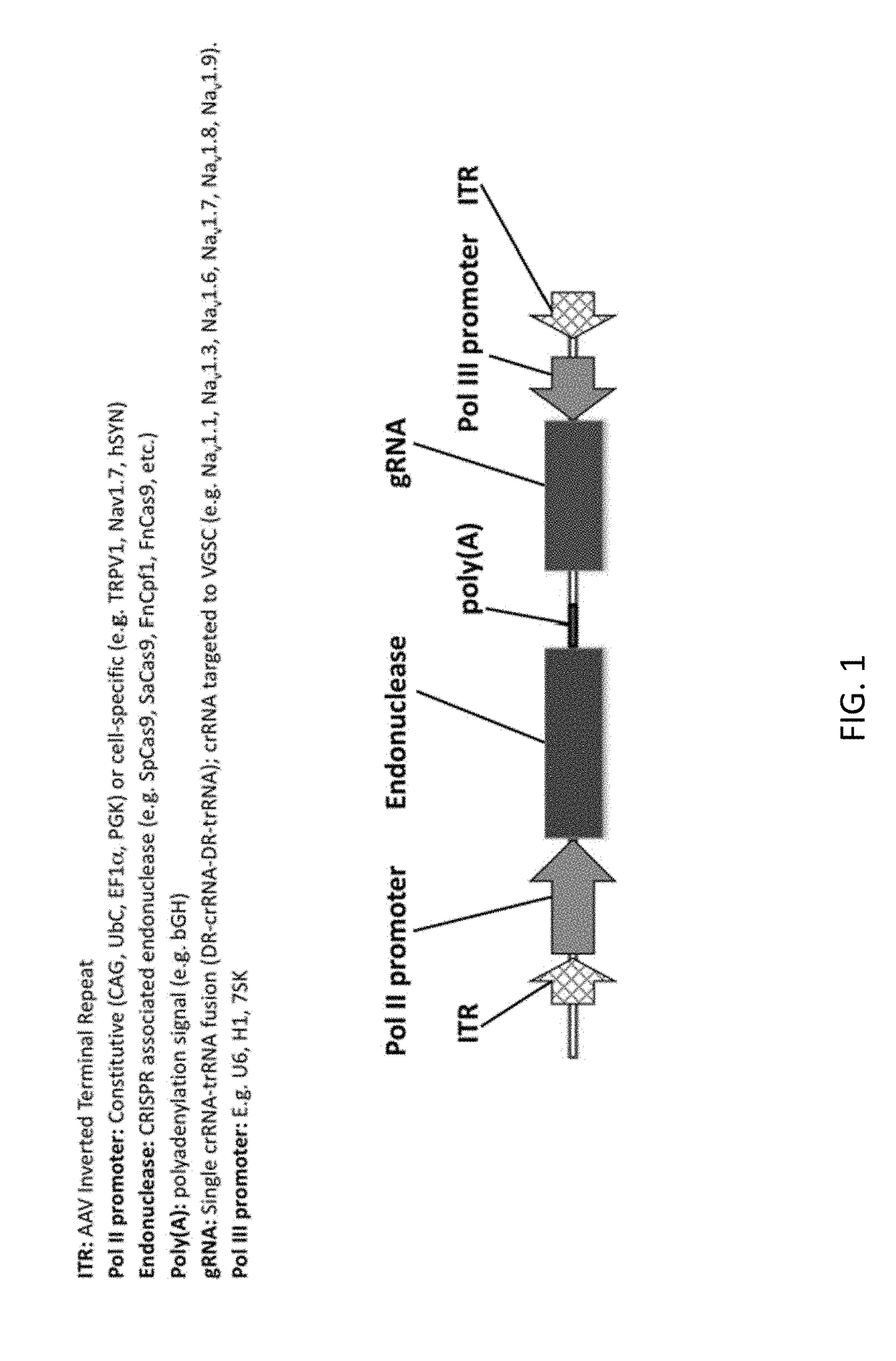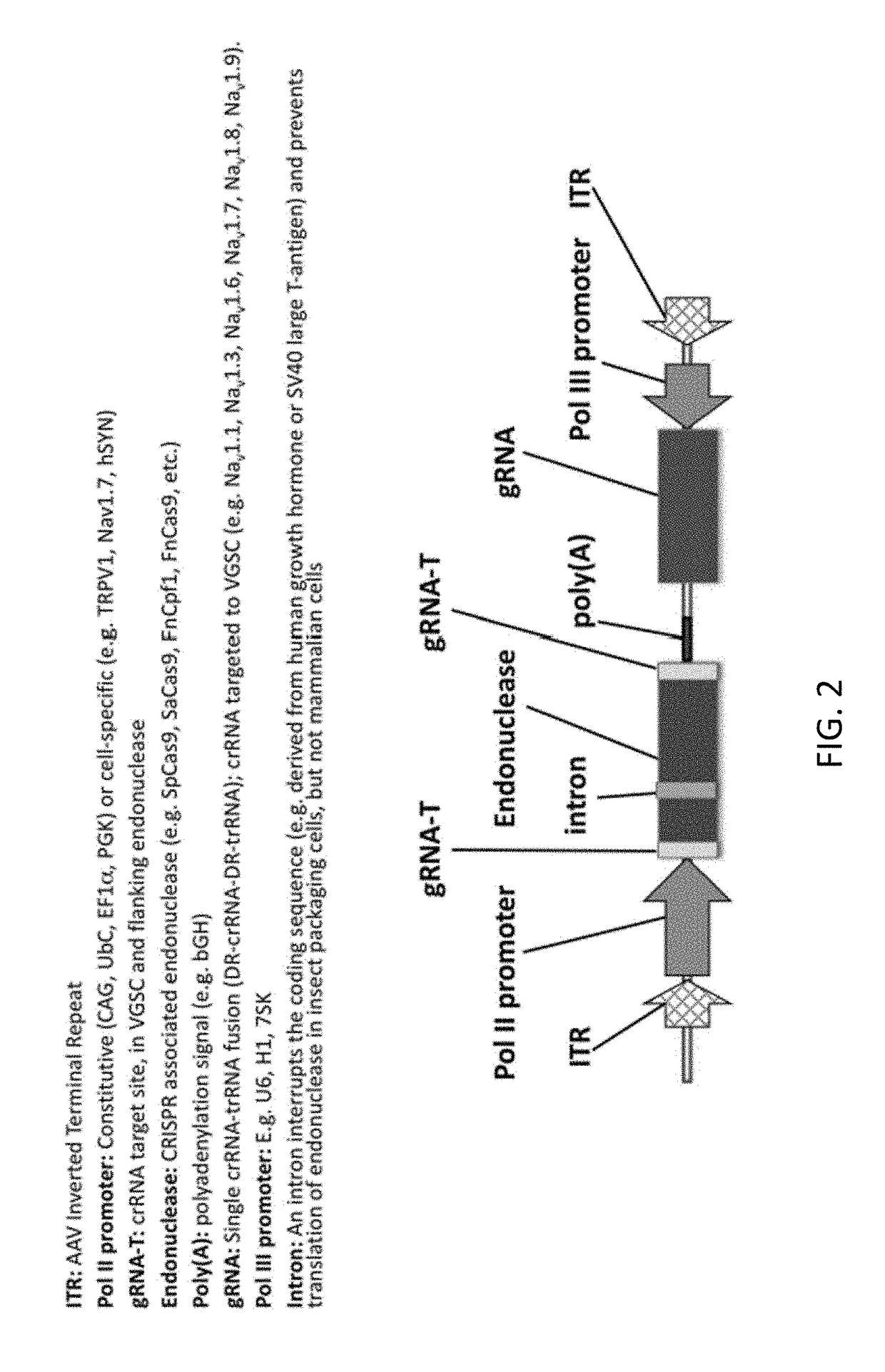Crispr compositions and methods of using the same for gene therapy
a technology of compositions and crispr, applied in the field of compositions, can solve the problems of severe developmental delay, refractory seizures, severe seizures, etc., and achieve the effects of reducing off-target effects, improving efficiency, and reducing seizures
- Summary
- Abstract
- Description
- Claims
- Application Information
AI Technical Summary
Benefits of technology
Problems solved by technology
Method used
Image
Examples
example 1
of a Patient Suffering from Chronic Pain
[0451]A patient suffering from chronic pain is treated using the compositions and methods disclosed herein. The patient is treated with 1015 vector genomes of AAV-hSYN1-Cas9 in a volume of 12.0 mL delivered into the subarachnoid space of the spinal cord (i.e., intrathecal). In this example, the AAV vector encodes the CRISPR Cas9 endonuclease derived from Streptococcus pyogenes under the control of the human Synapsin-1 (SYN1) promoter for selective neuronal expression (e.g. FIG. 1). The vector also contains an H1 promoter expressing a crRNA-trRNA fusion, with crRNA targeted to the Nav1.7 (SNC9A gene) voltage gated sodium channel. The patient experiences chronic pain relief within approximately 1 week of vector administration resulting from disruption of Nav1.7 channel function.
example 2
of a Patient Suffering from Chronic Pain
[0452]In a non-limiting example, a patient suffering from chronic radicular pain is treated using the compositions and methods disclosed herein. The patient is treated with 1013 vector genomes of AAV-hSYN1-Cpf1 in a volume of 1.0 mL delivered directly into one or more dorsal root ganglia (i.e., intraganglionic convection-enhanced delivery into lumbar, cervical, or thoracic DRGs). The specific DRGs responsible for signalling chronic pain are identified through a diagnostic selective nerve root block (e.g. lidocaine injection). In this example, the AAV vector encodes a transiently expressed CRISPR Cpf1 endonuclease derived from Francisella novicida flanked by gRNA target sites under transcriptional control of the human Synapsin-1 (SYN1) promoter for selective neuronal expression (e.g. FIG. 2-5). The vector also contains an H1 promoter expressing a crRNA-trRNA fusion, with crRNA targeted to the Nav1.7 (SNC9A gene) voltage gated sodium channel. Fo...
example 3
of a Patient Suffering from Chronic Pain
[0453]In another non-limiting example, a patient suffering from Trigeminal Neuralgia is treated using the compositions and methods disclosed herein. The patient is treated with 1013 vector genomes of AAV-hSYN1-Cpf1 in a volume of 1.0 mL delivered directly into one or both Trigeminal Ganglia (TGG). In this example, the AAV vector encodes a transiently expressed CRISPR Cpf1 endonuclease derived from Francisella novicida flanked by gRNA target sites under transcriptional control of the dox-inducible TRE3Gp promoter for transient expression (e.g. FIG. 6). The vector also contains H1 and U6 promoters expressing two unique gRNAs, with crRNAs targeted to disrupt Cpf1, rtTA, and the upstream regulatory region of the Nav1.7 (SNC9A gene) voltage gated sodium channel. Lastly, the vector cotains a donor template sequence consisting of the inducible PPAR-γ promoter which is exogenously regulated by administration of the FDA approved small molecule rosiglit...
PUM
| Property | Measurement | Unit |
|---|---|---|
| Tm | aaaaa | aaaaa |
| volume | aaaaa | aaaaa |
| volume | aaaaa | aaaaa |
Abstract
Description
Claims
Application Information
 Login to View More
Login to View More - R&D
- Intellectual Property
- Life Sciences
- Materials
- Tech Scout
- Unparalleled Data Quality
- Higher Quality Content
- 60% Fewer Hallucinations
Browse by: Latest US Patents, China's latest patents, Technical Efficacy Thesaurus, Application Domain, Technology Topic, Popular Technical Reports.
© 2025 PatSnap. All rights reserved.Legal|Privacy policy|Modern Slavery Act Transparency Statement|Sitemap|About US| Contact US: help@patsnap.com



